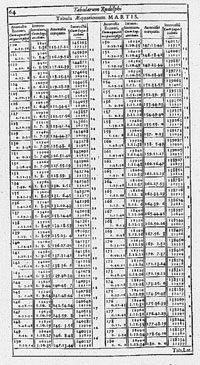Kepler and Astronomical Tables
 A page from Kepler's Rudolphine Tables.
A page from Kepler's Rudolphine Tables.Image by kind permission of the Master and Fellows of Trinity College, Cambridge.
Brahe's dying wish in 1601 was to complete an astronomical table for Rudolf II. Kepler was entrusted with this task, which allowed him access to Brahe's hitherto jealously guarded data. It was completed in 1624 and after protracted negotiations with Brahe's heirs, the imperial treasury and printers, the Rudolphine Tables were finally published in 1627 at Ulm and dedicated to dedicated to the Emperor Ferdinand II.
The Tables was far more accurate than its predecessors - its margin of error staying within 10 seconds compared to up to 5 degrees with earlier tables. Instead of providing a sequence of planetary positions for specified days (which Kepler did in his Ephemerides), the Rudolphine Tables were set up to allow calculations of planetary positions for any time in the past or future. The finding of the longitude of a given planet at a given time was based on Kepler's equation and he exploited logarithms for this tabulation. The precise geocentric positions had to be worked out from combining the heliocentric positions of the planets and the earth that were calculated separately. Logarithmic tabulations were used again to facilitate calculation. Thus, although Brahe wished the Tables to be based on his own system, it is clear from the way Kepler set up his tabulations that they were based on Kepler's own heliocentric system with elliptical planetary orbits.